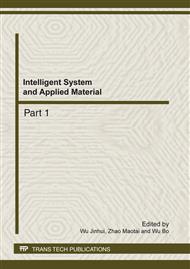[1]
P. Kumar, B. Prasad, I. M. Mishra, Catalytic ozonation of dimethyl phthalate over cerium supported on activated carbon, J. Hazard. Mater. 153 (2008) 635-641.
Google Scholar
[2]
P. Chingombe, B. Saha, R.J. Wakeman, Surface modification and characterization of a coal-based activated carbon, Carbon. 43 (2005) 3132-3143.
DOI: 10.1016/j.carbon.2005.06.021
Google Scholar
[3]
M.C. Pereira, F.S. Coelho, C.C. Nascentes, Use of activated carbon as a reactive support to produce highly active-regenerable Fe-based reduction system for environmental remediation, Chemosphere. 81 (2010) 7-12.
DOI: 10.1016/j.chemosphere.2010.07.056
Google Scholar
[4]
L. Gu, Z.X. Chen, C. Sun, Photocatalytic degradation of 2, 4-dichlorophenol using granular activated carbon supported TiO2, Desalination. 263 (2010) 107-112.
DOI: 10.1016/j.desal.2010.06.045
Google Scholar
[5]
T.D. Nguyen, N.H. Phan, M. H. Do, Magnetic Fe2MO4 (M: Fe, Mn) activated carbons: Fabrication, characterizationand heterogeneous Fenton oxidation of methyl orange, J. Hazard. Mater. 185 (2011) 653-661.
DOI: 10.1016/j.jhazmat.2010.09.068
Google Scholar
[6]
W. Zhang, W.D. Liu, Y. Lv, Enhanced carbon adsorption treatment for removing cyanide from coking plant effluent, J. Hazard. Mater. 184 (2010) 135-140.
DOI: 10.1016/j.jhazmat.2010.08.015
Google Scholar
[7]
C.S. Castro, M.C. Guerreiro, L.C. Oliveira, Iron oxide dispersed over activated carbon: Support influence on the oxidationof the model molecule methylene blue, Appl. Catal. A: Gen. 367 (2009) 53-57.
DOI: 10.1016/j.apcata.2009.07.032
Google Scholar
[8]
L.Q. Guo, F. Chen, X.Q. Fan, S-dopedα-Fe2O3 as a highly active heterogeneous Fenton-like catalyst towards the degradation of acid orange 7 and phenol, Appl. Catal. B: Environ. 96 (2010) 162-168.
DOI: 10.1016/j.apcatb.2010.02.015
Google Scholar
[9]
Y.J. Zhang, J. Ma, L. Zhang, Industrial Water Treatment. 1128 (2008). 72-77. In Chinese.
Google Scholar
[10]
X.T. Liu, X. Quan, L.L. Bo, Temperature measurement of GAC and decomposition of PCP loaded on GAC and GAC-supported copper catalyst in microwave irradiation, Appl. Catal. A: Gen. 264 (2004) 53-58.
DOI: 10.1016/j.apcata.2003.12.026
Google Scholar
[11]
K. Zhang, Z.D. Meng. Degradation of Rhodamine B by Fe-Carbon Nanotubes/TiO2 Composites under UV Light in Aerated Solution, Chin. J. Catal. 31(2010) 751-758.
DOI: 10.1016/s1872-2067(09)60084-x
Google Scholar


